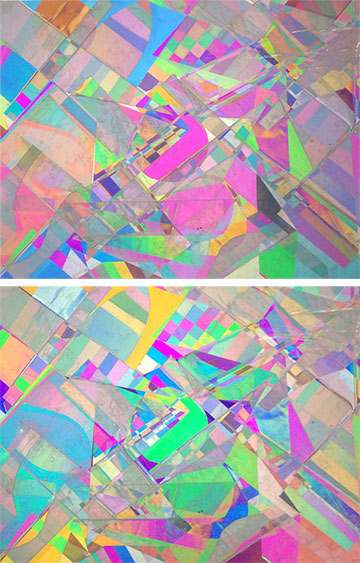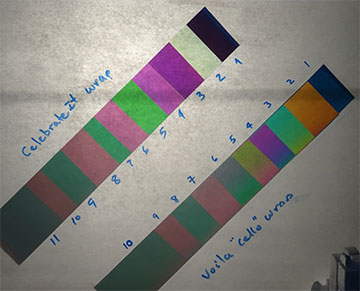An array of colors and patterns created by layering 12 strips of two different brands of clear packing tape at 45-degree angles on a glass plate. The plate is illuminated by a computer screen and photographed through polarized sunglasses held vertically. [Image: Courtesy of Aaron D. Slepkov] [Enlarge image]
Color patterns created by birefringent materials between polarizers are not only beautiful but are also used in technical applications like full-color LCDs, modern 3D glasses and microscopy. While birefringent color patterns are commonplace, the physical processes underlying them are complex.
To provide educators, students and artists with a foundation for understanding polarization-filtered coloration, Aaron Slepkov of Trent University, Canada, created demonstrations with polarized light that visually illustrate the elaborate mathematical concepts behind the phenomena (Am. J. Physics, doi: 10.1119/5.0087800).
Illuminating optical birefringence

A stained-glass-like image formed by layering different shapes of clear packing tape on a glass plate. Two different colorations emerge when the glass plate, illuminated by a white laptop screen, is photographed through polarized sunglasses held vertically (top) and rotated by 90 degrees (bottom). [Images: Courtesy of Aaron D. Slepkov]
Optical birefringence is a property of a material whose refraction index changes depending on the polarization and the propagation direction of light. Using simple experimental setups, Slepkov illustrates this property by “painting” with polarization, including layering birefringent materials, changing the alignment between two polarizers and varying optical thickness and observation angle.
For each of his demonstrations, Slepkov placed a variety of birefringent materials between an initial polarizer that polarizes incoming light and a second polarizer, called the analyzer, that has a rotatable axis. A laptop with a blank white screen served as both a light source and an initial polarizer, and polarized sunglasses acted as the analyzer.
To demonstrate how the layering of different birefringent materials changes perceived colors, Slepkov overlapped 12 pieces of two brands of clear packing tape oriented at 45 degrees to the initial polarizer. The observed colors varied when photographed through vertically aligned polarized sunglasses.
In a second demonstration, Slepkov created two different color schemes with the same collage by varying analyzer alignment. Here, an array of colors and patterns are created by layering clear packing tape on a glass plate. Two different colorations emerge when the glass plate, illuminated by a white laptop screen, is photographed through polarized sunglasses held vertically and then rotated 90 degrees.
Varying optical thickness and observation angle
The colors in this collage of transparent tape on glass change when the viewing angle changes. The glass plate was illuminated by a white laptop screen and photographed through a crossed polarizer. [Image: Courtesy of Aaron D. Slepkov] [Enlarge image]
The colors produced by a birefringent sample depend on the distance light must travel through the sample—and that distance can change depending on the viewer’s observation angle. Therefore, two people looking at the same birefringent sample from two different locations will see different colorations.
Slepkov demonstrated this concept using transparent adhesive tape on a glass plate illuminated by a white laptop screen and viewed at different angles through a crossed polarizer.
“Fun and intellectually stimulating”
“The manipulation of birefringent films for the purpose of creating color images is fun and intellectually stimulating. Much of the nuanced physics of polarization, birefringence, retardance and color theory can be observed in this accessible yet expansive endeavor,” said Slepkov in a press release.
Artist Austine Wood Comarow inspired Slepkov’s research into polarization filtering and observed colors. Comarow’s work includes applying polarization-filtered coloring techniques in fine art, coining the term “polage” for her polarization collages.
Slepkov, whose birefringent artwork was previously featured in OPN’s After Images, published a second paper detailing inexpensive experimental setups for quantitative measurement of birefringence in thin polymer films for secondary and undergraduate physics laboratories (Am. J. Physics, doi: 10.1119/5.0087798). The experimental designs grew out of an International Baccalaureate high school physics project conducted by Jan (Jack) Francis Beda, a son of Slepkov’s Trent University colleagues, Johann Beda and Rachel Wortis.



